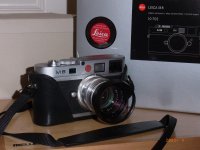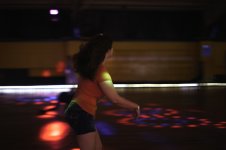I'm sure several forum members remember when this camera was announced.

I bought my M8 in Jan 2010 for $2500, still have and use it. A Zero-Defect CCD, I can use on Button-Dance Raw mode without having to map bad pixels. Same now as when bought had 400 exposures on it. I use Button-Dance and M8RAW2DNG to get the best image quality. This slows down the write time and requires use of the M8RAW2DNG post processor. Well worth it. The firmware on the M8 has less bugs than the M9 and M Monochrom, and probably less than all that follow. The company that wrote the firmware knew what it was doing.
The CCD in the M8 has higher dynamic range than the M9, the saturation count on the M8 is almost 50% higher than the M9. Between this and the 1/8000th top shutter speed, I can test just about any fast lens in full sun.
Last week picked up 5 new batteries for the M8, M9, and M Monochrom.

I bought my M8 in Jan 2010 for $2500, still have and use it. A Zero-Defect CCD, I can use on Button-Dance Raw mode without having to map bad pixels. Same now as when bought had 400 exposures on it. I use Button-Dance and M8RAW2DNG to get the best image quality. This slows down the write time and requires use of the M8RAW2DNG post processor. Well worth it. The firmware on the M8 has less bugs than the M9 and M Monochrom, and probably less than all that follow. The company that wrote the firmware knew what it was doing.
The CCD in the M8 has higher dynamic range than the M9, the saturation count on the M8 is almost 50% higher than the M9. Between this and the 1/8000th top shutter speed, I can test just about any fast lens in full sun.
Last week picked up 5 new batteries for the M8, M9, and M Monochrom.
Ko.Fe.
Lenses 35/21 Gears 46/20
M8 I had for year or so has shown less dynamic range than my M-E 220. Not as bad as some old cameras, but noticeable.
These days dynamic range term is misused by gear observers, in their twisted minds it is how much you could push underexposed image. Nor they knows how to use high iso. I had zero issues with M8‘s entire ISO range because I’m capable of taking exposure and understanding how to
These days dynamic range term is misused by gear observers, in their twisted minds it is how much you could push underexposed image. Nor they knows how to use high iso. I had zero issues with M8‘s entire ISO range because I’m capable of taking exposure and understanding how to
The Sensor in the M8 has a 71.5dB linear dynamic range, 60K saturation.
The Sensor in the M9 has 68.1dB linear dynamic range, 42K saturation.
From the Web, "The dynamic range of a CCD is typically defined as the full-well capacity divided by the camera noise and relates to the ability of a camera to record simultaneously very low light signals alongside bright signals. The ratio is often expressed in decibels which is calculated as 20log (Full well capacity/read noise) or in the equivalent number of A/D units required to digitize the signal."
The Sensor in the M9 has 68.1dB linear dynamic range, 42K saturation.
From the Web, "The dynamic range of a CCD is typically defined as the full-well capacity divided by the camera noise and relates to the ability of a camera to record simultaneously very low light signals alongside bright signals. The ratio is often expressed in decibels which is calculated as 20log (Full well capacity/read noise) or in the equivalent number of A/D units required to digitize the signal."
Bill Blackwell
Leica M Shooter
I had three M8 cameras, the first one purchased in around 2007. The second (an M8.2) was replaced with the third under warranty. I had a love-hate relationship with that camera from the beginning. With its cropped sensor (the 21mm was my favorite at the time) and the IR cut filters, as much as I tried to like it I could never make it happen.
However, if I were to go back knowing what I know now I think I'd still buy the M8, but ditch the IR cut filters and use it as a monochrome-only camera. IMHO, that's it at its best.


Leica M8.2
Tri-Elmar (50mm)
However, if I were to go back knowing what I know now I think I'd still buy the M8, but ditch the IR cut filters and use it as a monochrome-only camera. IMHO, that's it at its best.


Leica M8.2
Tri-Elmar (50mm)
The M8 is slightly sharper than the M9, due to a thinner IR cover glass. It is 0.5mm compared to 0.8mm of the M9 and M Monochrom. The IR leakage is 5% to 10%, depending on the specific portion of the band. I picked up IR cut filters for as cheap as $5 each. I knew to look for "Hot Mirror" filters as they were called in the early 90s, when IR leakage was a major problem for the first generation digital cameras.


Orange filter with the M8, custom Raw processing software.
Looks like the Infrared Ektachrome E3 I shot in the 1970s.


Orange filter with the M8, custom Raw processing software.
Looks like the Infrared Ektachrome E3 I shot in the 1970s.
micromontenegro
Well-known
I just recieved my old M8 back, she got a new shutter a while ago. Gawd, I LOVE this camera. I want to sell the newer ones.
 L2540082 by Aguaitacaminos, on Flickr
L2540082 by Aguaitacaminos, on Flickr
 L2540082 by Aguaitacaminos, on Flickr
L2540082 by Aguaitacaminos, on FlickrRange-rover
Mentor
I use M8RAW2DNG with the Button Dance, have since 2014. This unlocks uncompressed RAW mode that get converted to a 20MByte DNG file using the free software.
The M8 was crippled by the DNG-8 which is an absolutely terrible algorithm for compressing data. It is "Chaotic" and introduced color noise to high ISO images.

This is ISO2500 equivalent. If the M8 had delivered these results in 2006, would have been as good as the contemporaries.
Below- exposed at ISO160, pushed 5 stops for an equivalent ISO5000.

The M8 was crippled by the DNG-8 which is an absolutely terrible algorithm for compressing data. It is "Chaotic" and introduced color noise to high ISO images.

This is ISO2500 equivalent. If the M8 had delivered these results in 2006, would have been as good as the contemporaries.
Below- exposed at ISO160, pushed 5 stops for an equivalent ISO5000.

Share:
-
This site uses cookies to help personalise content, tailor your experience and to keep you logged in if you register.
By continuing to use this site, you are consenting to our use of cookies.



